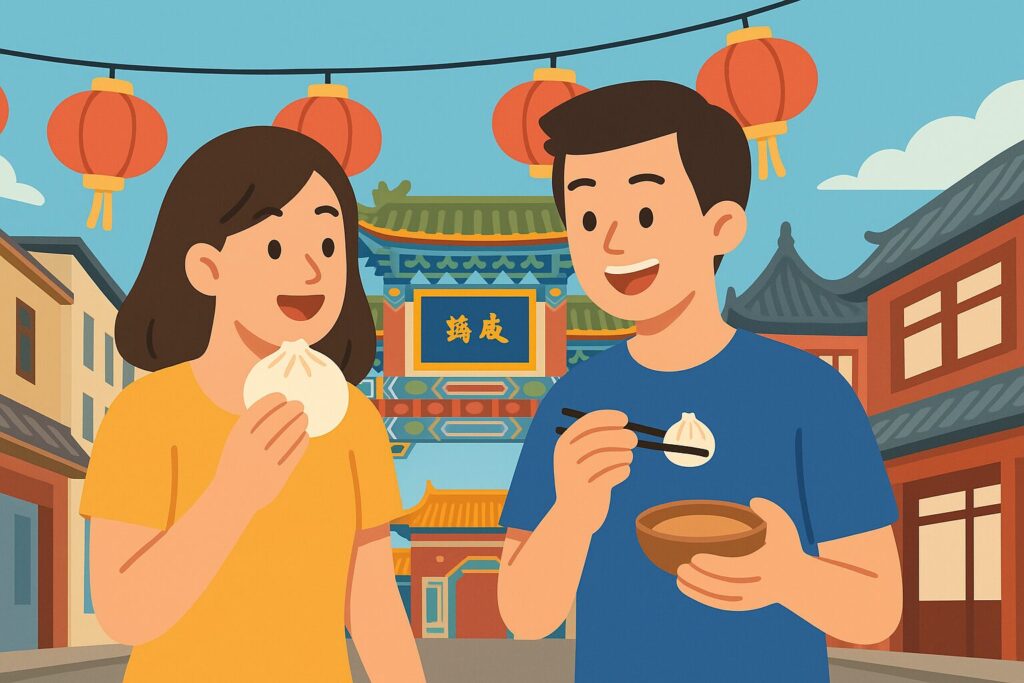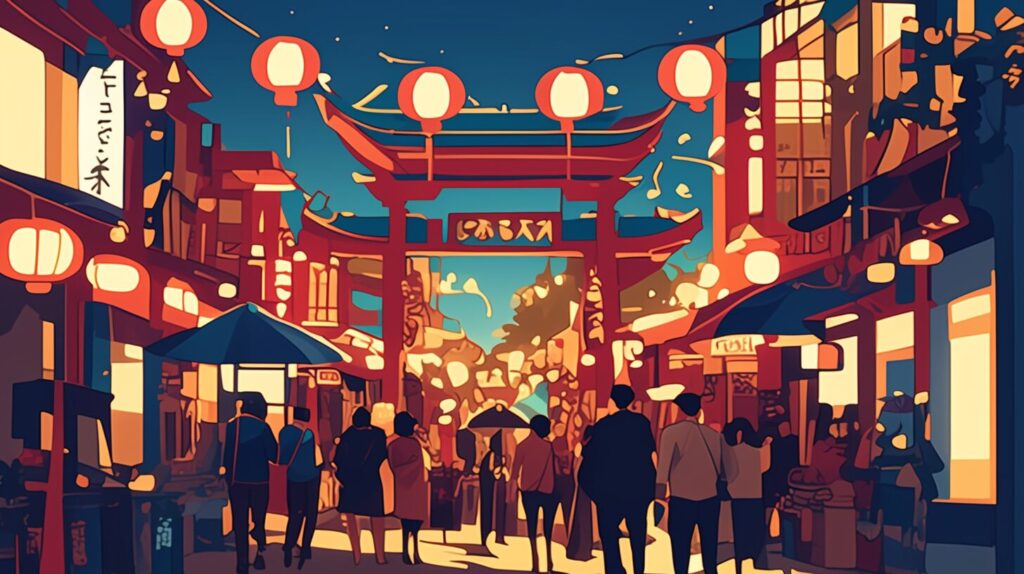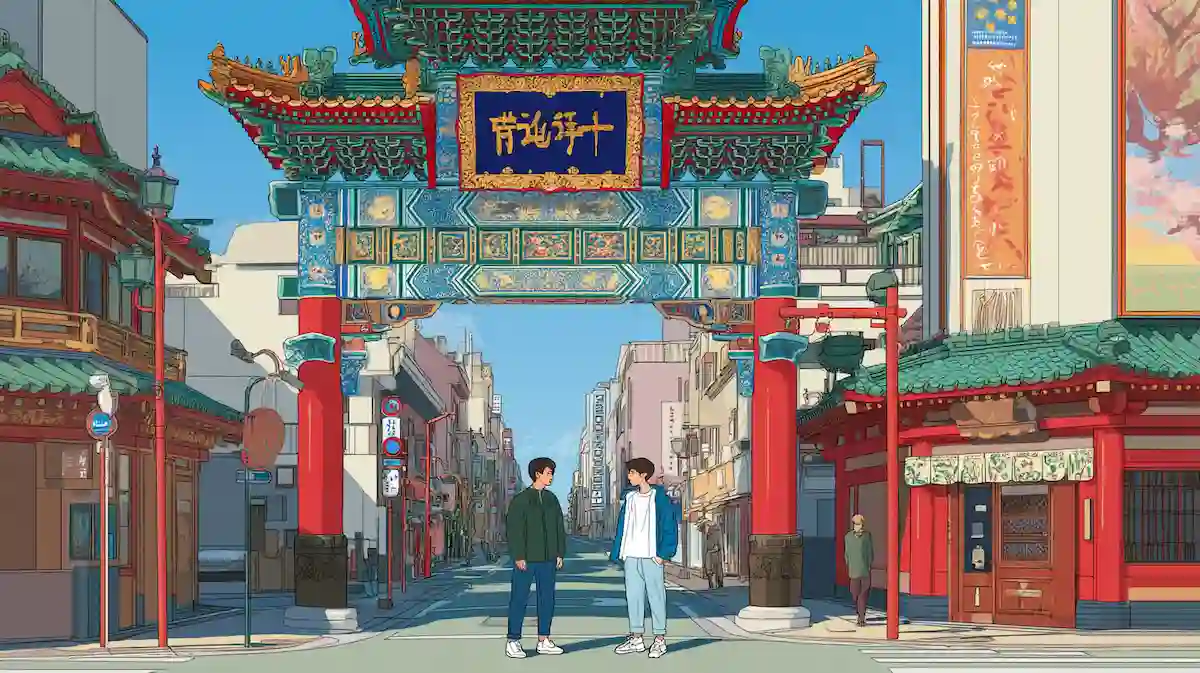横浜中華街を英語で説明・紹介するための基本情報と、英会話に役立つ表現をシンプルでわかりやすい英語で紹介します。
英会話ダイアローグ・概要・10の質問を通して、横浜中華街に関する英語表現を学びます。
英語
英会話ダイアローグを読む前に知っておくと良い前提知識と情報です。
- 横浜中華街の基本情報
- 所在地:東京から電車で約30〜45分ほどでアクセス可能
- 概要:日本最大の中華街で、エリア内に500軒以上の中華料理店や雑貨店が集まる観光名所
- 食文化
- 小籠包:スープの入った中国の点心で、中華街の人気グルメの一つ
- 肉まん:ふわふわの生地に豚肉を中心とした具材が入った、日本でもおなじみの点心
- 胡麻団子:甘い餡をもち米の生地で包み、ごまをまぶして揚げたお菓子
- 様々な本格中華料理店があり、広東料理や四川料理など多様な中国料理を楽しめる
- 見どころ
- 牌楼(パイロウ):中華街の象徴的な門で、10カ所に設置
- 善隣門(Zenrin-mon):横浜中華街のメインストリート入口にある、ひときわ目立つ門、写真撮影スポットとしても有名
- 関帝廟(Kanteibyo):商売の神様・関羽を祀る色鮮やかな寺院
- 媽祖廟(Masobyo):海の女神を祀る廟
- イベントとショッピング
- 春節(旧正月):獅子舞などの伝統的なパフォーマンスが行われる大きな祭り
- 中国茶、お守り、月餅、チャイナドレスなどの伝統的な商品が購入可能
- 食べ歩きができる屋台風の店舗や、食べ放題(バイキング形式)のレストランも一部ある
2人が横浜中華街について話しています。
おすすめの食べ物(小籠包、肉まん、ごま団子など)、10の門、関帝廟や媽祖廟などの見どころ、お土産などを話題にしています。
会話 / dialogue

Hey Key, have you ever been to Yokohama Chinatown?

Yeah, a couple of times! It’s one of my favorite places. Why do you ask?

I’m planning a day trip soon. I’ve never been, but I’ve heard it’s really exciting and full of amazing food.

That’s true! It’s the biggest Chinatown in Japan, and also one of the most famous in Asia.

Sounds impressive. What makes it so popular?

Well, there are over 500 shops and restaurants in a small area. You can explore so many different flavors and places.

I really want to try some authentic Chinese street food.

Then you’re in for a treat. The xiaolongbao is a must. It’s a soup dumpling—hot and juicy inside.

I saw pictures of that! What else should I look for?

You should try the nikuman—steamed pork buns. And don’t forget the sesame balls if you like sweets.

Nice. I heard some places offer all-you-can-eat. Is that true?

Yes, a few restaurants have it. It’s great if you want to try lots of dishes without worrying about the price.

That sounds fun. I might go for that. Better skip breakfast first!

Haha, probably a good idea. But Chinatown is more than just food, you know?

Oh yeah? Like what?

There are beautiful Chinese gates all over the area. There are ten in total, each based on feng shui and direction.

That sounds cool. Are they easy to find?

Yes, especially the Zenrin-mon gate—it’s the most famous and great for photos.

Are there any temples I should check out?

Absolutely. Visit Kanteibyo—it’s a colorful temple for the god of business. And there’s also Masobyo for the sea goddess.

Sounds like I’ll need a whole day just to see everything.

Probably! And don’t forget to check out the shops. They have nice souvenirs.

Like what?

Chinese teas, lucky charms, mooncakes, and even traditional clothes like cheongsams. Lots to choose from.

I might get some tea or a lucky charm. They sound perfect for souvenirs.

Great choices. Even without a special event, the atmosphere there feels like a mini trip to China.

Thanks, Key. I’m really looking forward to it now. Next time, let’s go together!
概要 / Overview
「横浜中華街」について、理解を深めるための「英語での概要」です。
横浜中華街

What Is Yokohama Chinatown?
Yokohama Chinatown is the largest Chinatown in Japan. It is located in Yokohama City, about 30 to 45 minutes from Tokyo by train. The area is small, but there are over 500 restaurants and shops. People visit to enjoy delicious Chinese food, beautiful streets, and a fun atmosphere.
Delicious Food to Try
One of the best parts of Yokohama Chinatown is the food. You can try many Chinese dishes like xiaolongbao (soup dumplings), nikuman (steamed pork buns), and sesame balls. Some restaurants offer all-you-can-eat meals. Street food is very popular, and you can eat while walking around.
Colorful Sights and Temples
There are 10 colorful Chinese gates around the area. Each gate is based on feng shui. The most famous gate is Zenrin-mon. You can also visit Kanteibyo, a temple for the god of business, and Masobyo, a temple for the sea goddess. These places are beautiful and peaceful.
Souvenirs and Events
There are many fun souvenirs to buy, such as Chinese tea, mooncakes, lucky charms, and traditional clothes. During Chinese New Year, big events like lion dances and parades happen. But even on a normal day, Yokohama Chinatown feels like a small trip to China.
10の質問 / 10 questions
「横浜中華街」について、理解を深めるための「英語での10の質問」です。
1: What is Yokohama Chinatown?
Yokohama Chinatown is the largest Chinatown in Japan. It has many Chinese restaurants, shops, and temples.
2: Where is Yokohama Chinatown located?
It is in Yokohama City, Kanagawa Prefecture, about 30 to 45 minutes from Tokyo by train.
3: What kind of food can I try there?
You can try xiaolongbao (soup dumplings), steamed pork buns, sesame balls, and many other Chinese dishes.
4: Are there street foods in Yokohama Chinatown?
Yes, there are many street food stalls where you can enjoy snacks while walking.
5: What is Zenrin-mon?
Zenrin-mon is the most famous gate in Yokohama Chinatown. It is colorful and great for photos.
6: How many gates are there in Yokohama Chinatown?
There are ten gates in total. Each gate is designed based on feng shui.
7: What temples can I visit in the area?
You can visit Kanteibyo, a temple for the god of business, and Masobyo, a temple for the sea goddess.
8: What souvenirs can I buy there?
You can buy Chinese tea, mooncakes, lucky charms, and traditional clothes like cheongsams.
9: Are there any special events in Yokohama Chinatown?
Yes, during Chinese New Year, there are lion dances, parades, and fireworks.
10: Why is Yokohama Chinatown popular?
It is popular because of its delicious food, beautiful buildings, rich culture, and easy access from Tokyo.

和訳付
会話 / dialogue

Hey Key, have you ever been to Yokohama Chinatown?
なあ、キー、横浜中華街に行ったことある?

Yeah, a couple of times! It’s one of my favorite places. Why do you ask?
うん、何回かあるよ!かなりお気に入りの場所だけど、どうして?

I’m planning a day trip soon. I’ve never been, but I’ve heard it’s really exciting and full of amazing food.
近いうちに日帰りで行こうと思ってさ。まだ行ったことないんだけど、すごく楽しくて美味しい食べ物がいっぱいあるって聞いたから。

That’s true! It’s the biggest Chinatown in Japan, and also one of the most famous in Asia.
その通り!日本で一番大きな中華街だし、アジアでも有名な中華街の一つなんだよね。

Sounds impressive. What makes it so popular?
それはすごいね。そんなに人気がある理由はなんなの?

Well, there are over 500 shops and restaurants in a small area. You can explore so many different flavors and places.
まあ、小さなエリアに500軒以上も店やレストランがあるからね。いろんな味や場所を楽しめるよ。

I really want to try some authentic Chinese street food.
本場の中華のストリートフードをぜひ試したいな。

Then you’re in for a treat. The xiaolongbao is a must. It’s a soup dumpling—hot and juicy inside.
それならきっと楽しめるよ。絶対に外せないのは小籠包。中が熱々ジューシーなスープ入りの餃子だよ。

I saw pictures of that! What else should I look for?
それ、写真で見たよ!他にもおすすめある?

You should try the nikuman—steamed pork buns. And don’t forget the sesame balls if you like sweets.
肉まんもぜひ食べてみて。あと、甘いものが好きならゴマ団子も忘れずにね。

Nice. I heard some places offer all-you-can-eat. Is that true?
いいね。一部の店では食べ放題があるって聞いたけど、本当?

Yes, a few restaurants have it. It’s great if you want to try lots of dishes without worrying about the price.
うん、いくつかのレストランがやってるよ。値段を気にせずに色んな料理を試せるからいいよね。

That sounds fun. I might go for that. Better skip breakfast first!
それ楽しそう。行くなら朝ごはん抜いていかないとね!

Haha, probably a good idea. But Chinatown is more than just food, you know?
はは、それはいい考えかもね。でも中華街は食べ物だけじゃないんだよ。

Oh yeah? Like what?
そうなの?例えば何?

There are beautiful Chinese gates all over the area. There are ten in total, each based on feng shui and direction.
エリア全体に綺麗な中国式の門があるんだよ。全部で10個あって、風水や方角に基づいているんだ。

That sounds cool. Are they easy to find?
それは面白そうだね。簡単に見つけられるの?

Yes, especially the Zenrin-mon gate—it’s the most famous and great for photos.
うん、特に「善隣門」っていう門は一番有名で、写真にもぴったりだよ。

Are there any temples I should check out?
お寺とかも見たほうがいいかな?

Absolutely. Visit Kanteibyo—it’s a colorful temple for the god of business. And there’s also Masobyo for the sea goddess.
もちろん。関帝廟は色鮮やかで商売の神様を祀ってる。あと、海の女神を祀る媽祖廟もあるよ。

Sounds like I’ll need a whole day just to see everything.
全部見るには丸一日必要になりそうだな。

Probably! And don’t forget to check out the shops. They have nice souvenirs.
そうだね!あと、お店巡りも忘れないでね。素敵なお土産があるから。

Like what?
例えばどんなの?

Chinese teas, lucky charms, mooncakes, and even traditional clothes like cheongsams. Lots to choose from.
中国茶や開運グッズ、月餅、チャイナドレスみたいな伝統的な服もあるよ。色々選べるよ。

I might get some tea or a lucky charm. They sound perfect for souvenirs.
お茶とか開運グッズはいいね。お土産にぴったり。

Great choices. Even without a special event, the atmosphere there feels like a mini trip to China.
いいチョイスだね。特別なイベントがなくても、あそこはちょっとした中国旅行気分を味わえるよ。

Thanks, Key. I’m really looking forward to it now. Next time, let’s go together!
ありがとう、キー。すごく楽しみになってきたよ。次は一緒に行こうね!
概要 / Overview
横浜中華街

What Is Yokohama Chinatown?
Yokohama Chinatown is the largest Chinatown in Japan. It is located in Yokohama City, about 30 to 45 minutes from Tokyo by train. The area is small, but there are over 500 restaurants and shops. People visit to enjoy delicious Chinese food, beautiful streets, and a fun atmosphere.
横浜中華街とは?
横浜中華街は、日本で一番大きな中華街です。場所は横浜市にあり、東京から電車で約30〜45分ほどで行けます。エリアは小さいですが、500軒以上のレストランやお店があります。人々は、おいしい中華料理や美しい街並み、楽しい雰囲気を楽しむために訪れます。
Delicious Food to Try
One of the best parts of Yokohama Chinatown is the food. You can try many Chinese dishes like xiaolongbao (soup dumplings), nikuman (steamed pork buns), and sesame balls. Some restaurants offer all-you-can-eat meals. Street food is very popular, and you can eat while walking around.
おすすめのグルメ
横浜中華街の魅力のひとつは、なんといっても食べ物です。小籠包(スープ入り餃子)、肉まん、ごま団子など、さまざまな中華料理を楽しめます。一部のレストランでは食べ放題もあります。ストリートフードもとても人気で、歩きながら食べるのが定番です。
Colorful Sights and Temples
There are 10 colorful Chinese gates around the area. Each gate is based on feng shui. The most famous gate is Zenrin-mon. You can also visit Kanteibyo, a temple for the god of business, and Masobyo, a temple for the sea goddess. These places are beautiful and peaceful.
カラフルな門とお寺
中華街には、色とりどりの中国風の門(牌楼)が10基あります。それぞれが風水に基づいて設計されています。一番有名なのは善隣門です。また、商売の神様を祀る関帝廟や、海の女神を祀る媽祖廟も見どころで、美しくて静かな場所です。
Souvenirs and Events
There are many fun souvenirs to buy, such as Chinese tea, mooncakes, lucky charms, and traditional clothes. During Chinese New Year, big events like lion dances and parades happen. But even on a normal day, Yokohama Chinatown feels like a small trip to China.
お土産とイベント
中国茶や月餅、開運グッズ、チャイナ服など、買って楽しいお土産がたくさんあります。春節(旧正月)には、獅子舞やパレードなど大きなイベントも行われます。でも、普段の日でも、横浜中華街はまるで小さな中国旅行のような雰囲気を楽しめます。
10の質問 / 10 questions
1: What is Yokohama Chinatown?
横浜中華街とは何ですか?
Yokohama Chinatown is the largest Chinatown in Japan. It has many Chinese restaurants, shops, and temples.
横浜中華街は日本で最大の中華街で、多くの中華料理店やお店、お寺があります。
2: Where is Yokohama Chinatown located?
横浜中華街はどこにありますか?
It is in Yokohama City, Kanagawa Prefecture, about 30 to 45 minutes from Tokyo by train.
神奈川県横浜市にあり、東京から電車で約30〜45分の場所にあります。
3: What kind of food can I try there?
そこでどんな食べ物が楽しめますか?
You can try xiaolongbao (soup dumplings), steamed pork buns, sesame balls, and many other Chinese dishes.
小籠包(スープ入り餃子)、肉まん、ごま団子など、さまざまな中華料理を楽しめます。
4: Are there street foods in Yokohama Chinatown?
横浜中華街にはストリートフードがありますか?
Yes, there are many street food stalls where you can enjoy snacks while walking.
はい、多くの屋台があり、歩きながらスナックを楽しめます。
5: What is Zenrin-mon?
善隣門とは何ですか?
Zenrin-mon is the most famous gate in Yokohama Chinatown. It is colorful and great for photos.
善隣門は横浜中華街で最も有名な門で、色鮮やかで写真映えするスポットです。
6: How many gates are there in Yokohama Chinatown?
横浜中華街にはいくつ門がありますか?
There are ten gates in total. Each gate is designed based on feng shui.
全部で10の門があり、それぞれ風水に基づいて設計されています。
7: What temples can I visit in the area?
そのエリアで訪れられるお寺はどこですか?
You can visit Kanteibyo, a temple for the god of business, and Masobyo, a temple for the sea goddess.
商売の神様を祀る関帝廟と、海の女神を祀る媽祖廟を訪れることができます。
8: What souvenirs can I buy there?
そこでどんなお土産が買えますか?
You can buy Chinese tea, mooncakes, lucky charms, and traditional clothes like cheongsams.
中国茶、月餅、開運グッズ、チャイナドレスなどの伝統的な服がお土産として買えます。
9: Are there any special events in Yokohama Chinatown?
横浜中華街では特別なイベントがありますか?
Yes, during Chinese New Year, there are lion dances, parades, and fireworks.
はい、春節(旧正月)の時期には獅子舞、パレード、花火などのイベントがあります。
10: Why is Yokohama Chinatown popular?
なぜ横浜中華街は人気があるのですか?
It is popular because of its delicious food, beautiful buildings, rich culture, and easy access from Tokyo.
おいしい食べ物、美しい建物、豊かな文化、そして東京からのアクセスの良さが人気の理由です。

words & phrases
英会話ダイアローグと関連情報に出てきた単語・フレーズです(例文は各3つ)。

authentic : 形容詞
意味:本物の、正真正銘の。Real, genuine, and true to the original style or tradition.
(横浜中華街の「authentic Chinese street food(本格的な中華の屋台料理)」を指す)
例文:
- This is an authentic Italian pizza made in a wood-fired oven.
「これは薪窯で焼いた本格的なイタリアンピザです。」 - The museum displays authentic samurai swords.
「その博物館には本物の日本刀が展示されています。」 - I want to try some authentic Chinese food in Chinatown.
「中華街で本格的な中華料理を食べてみたいです。」
dumpling : 名詞
意味:団子、餃子。A small piece of dough, often filled with meat or vegetables, and cooked by boiling, steaming, or frying.
(「soup dumplings(スープ入りの餃子=小籠包)」を指す)
例文:
- I ordered pork dumplings with soy sauce.
「私は醤油付きの豚肉餃子を注文しました。」 - These dumplings are filled with shrimp and vegetables.
「この餃子にはエビと野菜が入っています。」 - She made homemade dumplings for dinner.
「彼女は夕食に手作り餃子を作りました。」
steamed : 形容詞
意味:蒸した。Cooked by using steam.
(「steamed pork buns(蒸した豚まん)」などの料理の調理法を示す)
例文:
- I had steamed dumplings for lunch.
「昼ごはんに蒸し餃子を食べました。」 - This dish comes with steamed vegetables.
「この料理には蒸し野菜がついてきます。」 - We usually eat steamed rice with our meals.
「私たちは普段の食事に蒸しごはんを食べます。」
feng shui : 名詞
意味:風水。A Chinese system of arranging buildings, rooms, or objects to create harmony and balance.
(横浜中華街の「gates based on feng shui(風水に基づいて設計された門)」に関する記述)
例文:
- The house was designed using feng shui principles.
「その家は風水の原則に基づいて設計されました。」 - She placed the mirror according to feng shui advice.
「彼女は風水のアドバイスに従って鏡を置きました。」 - In Chinatown, some gates are built based on feng shui.
「中華街では、いくつかの門が風水に基づいて建てられています。」
